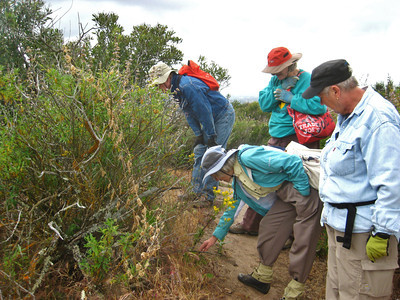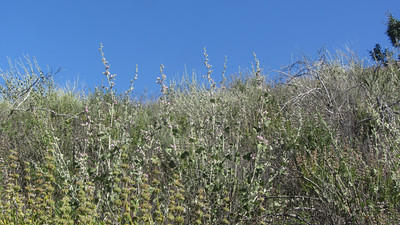Rock Oak Habitat Restoration

Volunteers collecting seeds from a chaparral patch in Lime Ridge
Background on the Rock Oak Project
The current chaparral project is really a continuation of the former quail project originated by Bob Wisecarver and fellow WCOSF board members. During those past times, six large enclosures were built on locations within the grasslands. The first, adjoining Borges Ranch is now the well recognized Bob Wisecarver Quail Gully. Twin Ponds was another location and four more were developed in North Lime Ridge along the ephemeral stream we might call Rock Oak Creek. Plantings and cuttings were made of various species of willow, coyote bush, quail bush, buck brush, California sagebrush, elderberry, California buckeye, oaks, toyon, yerba santa and others. Much was learned from the effort. Abundant representatives of some of these species exist at this time.To this ambitious project of the past, sixteen more small enclosures were added between the Wisecarver Quail Gully and Twin Ponds. The specific purpose was to connect the former projects by way of a wildlife corridor through a grazing area.

Diverse chaparral patch containing Black Sage, Malacothamnus, California Sage, and possibly other species
Current Sucesses
For a number of years now plantings and seed sowings have proceeded in all of these new enclosures as well as within the earlier locations. Coyote bush has flourished particularly on the mesic habitats. California sagebrush established readily wherever planted, but is less adaptable as wildlife shelter though it serves well as a seed plant for some creatures. Black sage was also selected for trials. A few potted specimens from the Foundation's nursery were planted on prepared clearings within otherwise dense grass cover. No special care was given after planting. Remarkably, survival and growth has been excellent.With that good news more trials were made with seeds of chamise and black sage collected from the Boundary Oaks chaparral field and from adjoining Shell Ridge lands of East Bay Regional Parks. Arrangements were made with the Watershed Nursery of Richmond, California for production of planting stock from that seed. After creating seed beds in habitat currently occupied by extended thickets of black mustard and Italian thistle, the chamise was planted. Very little survival developed. And then a very much enlarged territory in the same enclosures was planted with 400 black sage. The three inch tall seedlings that were started in "stubby" liners grew very well. About 90% survival was achieved. And now in dense groves, some stand thirty-six inches tall.
Rock Oak Restoration
Our effort to create or improve wildlife habitat and corridors continues. This includes establishment of woody plant cover on sites having open expansive grassland either entirely or dominantly. We anticipate woody plant corridors of sufficient density to permit wildlife movement, resting, nesting, feeding, and sheltering without excessive interference from people. We expect this effort will include some habitat patches of sufficient size for more permanent residence by wildlife and will provide for high quality esthetic interest for outdoor recreationists.The ideal for wildlife management is a mosaic pattern of habitats in close enough proximity to one another. Wildlife populations tend to be greater at the ecotones between such cover. It is the ideal to consider ample circumstances of food, water and cover for wildlife.
Habitat is still dominated by expansive grasslands of non-native annual grasses and forbs. Some other zones do have widespread mature oaks with no protective cover between.
Gary Muerle and David Ogden




 Join/Renew
Join/Renew Donate
Donate Volunteer
Volunteer Maps
Maps Newsletter
Newsletter Facebook
Facebook
